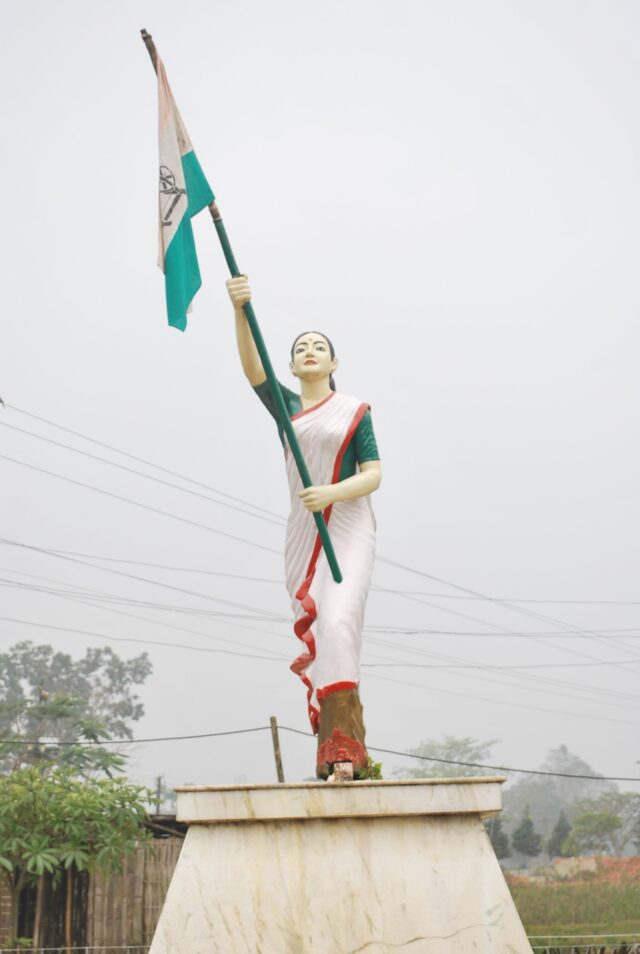
A rebellious young Assamese girl, Kanaklata Barua, embraced death at the peak of the Quit India Movement in 1942. She was inspired by the stories of contemporary Assamese freedom fighters such as Kushal Konwar, the then President of the local Congress Committee who the British falsely implicated on a charge of the train derailment.
At the age of only 17 years, Kanaklata joined a suicide squad called Mrityu Bahini consisting of young volunteers. Earlier, her plea to join Subhash Chandra Bose’s Azad Hind Fauj was rejected because she was still a minor. As a teenager, Kanaklata attended the secret meetings of various students’ organisations then active in her village.
On September 20, 1942, the revolutionary wing of the Gohpur sub-division of the undivided Darrang district decided to remove the British flag and unfurl the national flag of India in the local police station at Gohpur.
Kanaklata volunteered to lead a procession of around 5,000 unarmed villagers and youngsters, mostly students, for the daunting task. About 500 women from the neighbouring villages joined the procession.
Kanaklata was able to strike a chord of familiarity with everyone. Volunteers from Tezpur, Dhekiajuli, and several other places gathered in the morning of September 20, 1942, in the main camp at Kalyanpur Circle (mouza) to register themselves as a part of different death squads. Two days before, on Sept. 18, a meeting was organised in the main Namghar, presided over by Maghiram Bora.
In this meeting, Kanaklata had requested Pushpalata Das to get her name enlisted in the Mrityu Bahini, which was entrusted with the responsibility of carrying out perilous patriotic acts. Kanaklata’s name was formally registered as a part of the Mrityu Bahini on September 20 at the Kalyanpur camp. Her impassioned speech just a few hours before her death left the audience spellbound.
Kanaklata was a dedicated young lady who was granted membership of the group, although she was below 18 years (the minimum age for joining the Mrityu Bahini) at the time of registration. Owing to her exceptional qualities, it was a different case. She was subsequently made the leader of the women cadres of the Mrityu Bahini. Kanaklata promised her grandfather that she would live up to the proud reputation of his Ahom ancestry, while confronting the British Police-in-Charge of the Gohpur police station where the national flag was to be hoisted.
Kanaklata marched ahead, leading the huge crowd of women volunteers from the front. The slogans of Vande Mataram and instruments like conch-shells, drums, flutes and brass shells which were being played all along the way to the police station filled the air with exuberance. Kanaklata refused to apologise in front of the then officer-in-charge of the police station, Rebati Mohan Som, and his armed constables, who were ready to shoot.
He repeatedly warned the crowd of deadly consequences if they went ahead with their plan. Kanaklata sternly asked him to do his duty while she would carry on with hers. She entered the police station compound, saying that they could only kill their mortal bodies, but not their souls. With no warning or dispersal order, the police opened fire. Kankalata was shot dead right on the chest, her blood-stained youthful hands still holding the tricolour high with pride. It was picked up by her fellow compatriot Mukunda Kakoti who, too, was killed by gunshots in the same spot. Another leader, Hemakanta Baruah, met the same fate. He was then a minor school-going boy aged 16. Several other volunteers were grievously injured.
Despite such repression, the tricolour was eventually hoisted at the police station in the evening by one Rampati Rajkhowa. Thereafter, the Quit India Movement in Assam intensified in several places of Darrang district, such as Kalabari, Gohpur, Jamugurihat, Tezpur, etc. The name ‘Kanaklata’ stands for revolution against oppression and injustice in Assam even today. Her memory continues to live on in the socio-political and cultural spaces of Assam, even to this day.
Courtesy : VSK BHARATH














